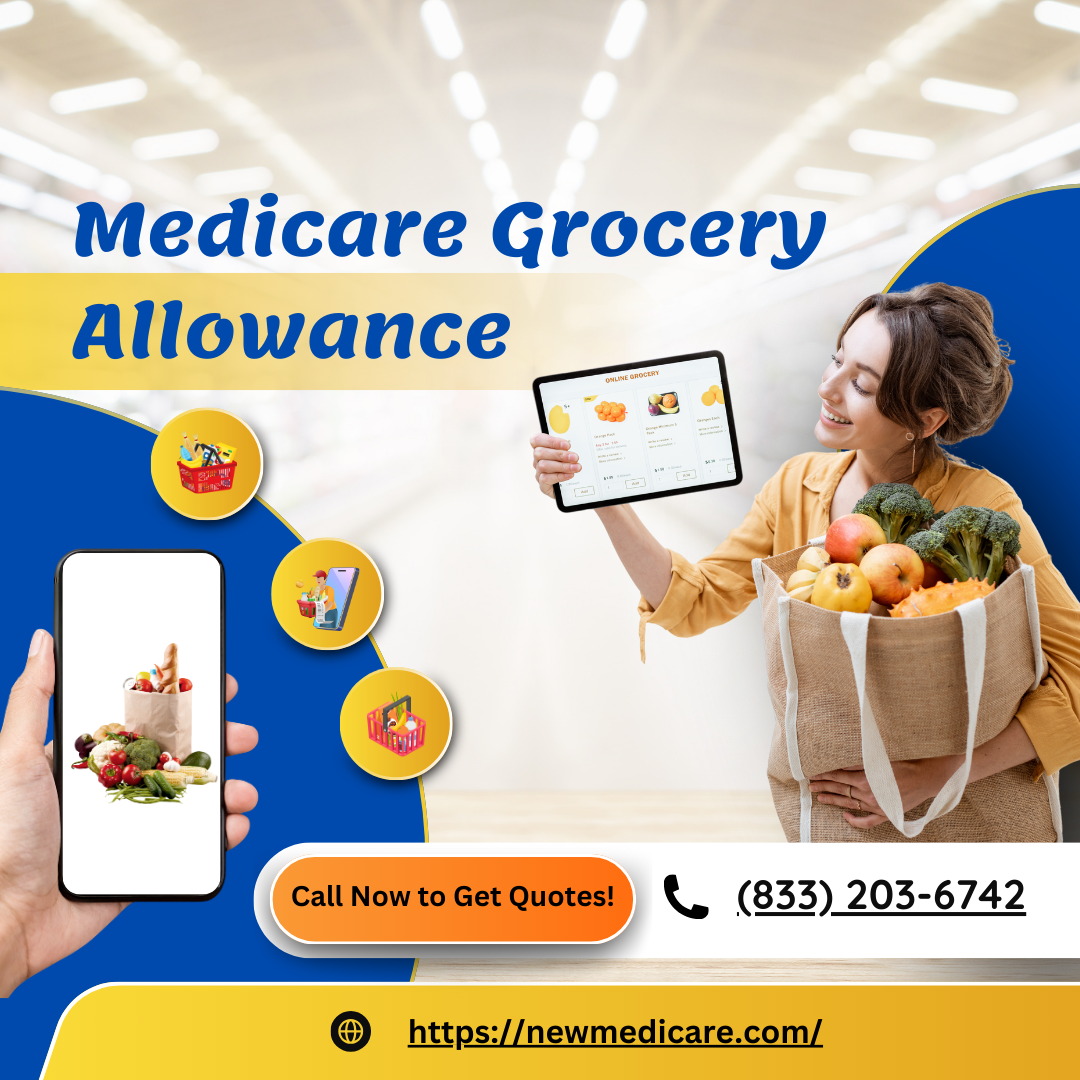Medicare Grocery Allowance: Are You Missing Out on Food Savings?
If you’re a Medicare recipient, you might have heard about the Medicare grocery allowance, a benefit that’s making waves in 2025 as rising food prices hit seniors the hardest. Are rising food costs making it harder for you to manage your monthly budget? The Medicare Grocery Allowance might be the relief you need! But what exactly is it? Is it available, and can you qualify for up to $900 or even $3,000 monthly to cover your grocery expenses?
While Original Medicare doesn’t cover food, certain Medicare Advantage plans are stepping in to offer much-needed assistance to those facing food insecurity. Let’s dive into everything you need to know about the Medicare grocery allowance, from eligibility to how you can apply.
What is the Medicare Grocery Allowance?
The Medicare Grocery Allowance is a supplemental benefit offered through some Medicare Advantage plans. This allowance helps beneficiaries purchase nutritious food, which can significantly enhance their health and well-being. Unlike traditional Medicare, which does not cover food costs, certain Medicare Advantage plans include this benefit to promote healthier lifestyles for seniors.
Some plans even go beyond offering cash allowances and provide meal delivery services, delivering pre-prepared meals to your door, which is particularly helpful for individuals with chronic conditions or limited mobility.
How Does the Grocery Allowance Work?
The grocery allowance typically provides a set amount of money each month that can be used toward grocery or meal services. Beneficiaries can use this allowance at certain participating stores (both national chains and local markets) or for meal delivery services offered by the insurance provider.
- Spending Your Allowance: The allowance is often loaded onto a prepaid card that can be used at authorized grocery stores or for meal delivery services. You can use it to buy healthy foods like fruits, vegetables, whole grains, and lean proteins.
- Restrictions on Spending: Some plans may limit the use of the allowance to specific food types or vendors, and it may exclude non-food items like alcohol.
- Tracking Your Allowance: Many plans provide online tools or apps to help track how much of the allowance has been spent, ensuring you stay within the limits.
Eligibility for Medicare Grocery Allowance
The Medicare grocery allowance is not part of Original Medicare (Part A and Part B). Instead, it’s tied to Medicare Advantage (Part C) plans, which are offered by private insurance companies. To qualify, you must be enrolled in a Medicare Advantage plan that includes this benefit.
Who Qualifies?
To qualify for a grocery allowance, you must meet the following requirements:
- Medicare Advantage Enrollment: You must be enrolled in a Medicare Advantage plan that offers this benefit.
- Health Conditions: Some plans prioritize individuals with chronic health conditions like diabetes, heart disease, or hypertension.
- Income and Financial Need: Some plans offer the allowance to seniors with lower incomes, helping those facing financial hardship.
- Location: Availability can vary depending on where you live. Some rural areas may not have access to grocery delivery services or the plans offering grocery allowances.
How to Enroll in a Plan with Grocery Benefits
If you’re not already enrolled in a Medicare Advantage plan with a grocery allowance, you can apply during one of the following enrollment periods:
- Initial Enrollment Period (IEP): When you first become eligible for Medicare.
- Annual Enrollment Period (AEP): Typically runs from October 15 to December 7 each year.
- Special Enrollment Period (SEP): Available under certain circumstances, such as moving to a new area.
You can compare Medicare Advantage plans with grocery benefits using the Medicare Plan Finder tool to see which plans are available in your area.
How to Use the Medicare Grocery Allowance
Using it is simple once you qualify for a grocery allowance through your Medicare Advantage plan. Here’s what you can expect:
Spending Your Allowance
The grocery allowance can typically be used at participating grocery stores or meal delivery services. Some plans even provide prepaid debit cards, making it easier for beneficiaries to access their allowance. If your plan partners with meal delivery services, you may be able to use your allowance to receive nutritious meals delivered directly to your door.
Restrictions on Spending
While the allowance helps cover the cost of food, there may be restrictions on what can and cannot be purchased. For example, some plans limit the purchase of non-food items or alcoholic beverages. Additionally, you may only be able to use your allowance at specific retailers or through approved meal delivery services.
Tracking Your Allowance
Medicare Advantage plans with grocery allowances often offer apps or online portals that allow you to track your spending. These tools ensure you stay within the limits of your allowance and make the most of the benefit.
Medicare Advantage Plans Offering Grocery Allowances
Not all Medicare Advantage plans provide a grocery allowance, but several top-rated providers do. If you’re looking for a plan with this benefit, here are some providers to consider:
Top Medicare Advantage Plans with Grocery Allowance:
- Humana: Humana is known for offering extensive Medicare Advantage benefits to enrollees, including grocery allowances. Their plans provide flexibility, offering both grocery discounts and meal delivery services.
- UnitedHealthcare: UnitedHealthcare offers grocery allowances as part of their Medicare Advantage plan and other healthy living benefits. Eligible enrollees can use their allowance at a variety of grocery stores or meal delivery services.
- Cigna: Cigna offers select Medicare Advantage plans with grocery allowances to help beneficiaries purchase healthy food, especially for those with chronic conditions.
Comparing Grocery Allowance Benefits
The amount of the grocery allowance can vary widely depending on the plan and location. Some plans offer a modest monthly allowance (e.g., $25 to $50), while others provide more substantial allowances. Be sure to compare the grocery allowance offered by different plans to find one that best fits your needs and budget.

How to Choose the Right Medicare Plan with a Grocery Allowance
When choosing a Medicare Advantage plan with a grocery allowance, several factors should be considered:
Key Factors to Consider:
- Coverage Area: Ensure the plan offers grocery services and delivery in your area.
- Cost of the Plan: While some Medicare Advantage plans with grocery allowances may have higher premiums, they could be worth the investment if the grocery allowance reduces your overall food costs.
- Additional Benefits: Many plans offer extra perks, such as fitness programs, dental care, and vision coverage. Assess whether these benefits are important to you.
Understanding Plan Documents
Before enrolling, review the plan documents carefully. Look for details about how the grocery allowance works, how much is provided, and which stores or services are covered.
Grocery Allowance and Its Impact on Health and Well-being
A Medicare grocery allowance is more than just a financial benefit—it can profoundly impact seniors’ health and well-being. Here’s how:
Improved Nutrition
Nutritious food is essential for seniors, especially those managing chronic conditions. The grocery allowance helps seniors purchase healthier food, which can lower the risk of malnutrition and chronic diseases such as heart disease, diabetes, and hypertension.
Addressing Food Insecurity
Many seniors face food insecurity, struggling to afford adequate food. The grocery allowance alleviates this issue by ensuring that those on Medicare have access to nutritious options.
Social and Emotional Benefits
Meal delivery services can also provide a vital social connection for seniors with limited mobility. Regular meal delivery helps reduce isolation, allowing seniors to feel more independent and cared for.
Challenges and Controversies
While the Medicare grocery allowance provides substantial benefits, there are some challenges:
- Limited Allowance Amounts: Some beneficiaries may find that the monthly allowance isn’t enough to cover all of their grocery costs.
- Access to Services: Not all areas may have access to grocery delivery services, limiting the benefit for those in rural locations.
Despite these challenges, many beneficiaries find that the grocery allowance provides valuable support in maintaining their health.
Frequently Asked Questions (FAQs)
1. Does Medicare Offer a Grocery Allowance?
Original Medicare (Parts A and B) does not offer a grocery allowance. However, some Medicare Advantage plans (Part C) provide this benefit as an additional perk. These plans are offered by private insurance companies approved by Medicare, and many now include grocery assistance to help seniors with the rising cost of food.
2. What is the Medicare Grocery Allowance for Seniors in 2025?
Some Medicare Advantage plans offer this benefit to help seniors purchase food. Some plans offer up to $900 per month.
3. Is the $900 Medicare Grocery Allowance Real?
Yes, some Medicare Advantage plans are offering $900 allowances, though availability varies by location and plan.
4. How Do I Know if I’m Eligible for the Grocery Allowance?
You must be enrolled in a Medicare Advantage plan that offers this benefit. Eligibility may depend on your health, income, or location.
5. Can I Apply for the Grocery Allowance if I Already Have Medicare?
If you’re on Original Medicare, you must switch to a Medicare Advantage plan to qualify.
6. What Does the $3,000 Food Allowance Mean for Seniors?
This is a special benefit available through certain health programs, but it’s not common across standard Medicare Advantage plans.
7. Can You Qualify for a $3,000 Food Allowance?
The $3,000 food allowance is not a standard benefit under Medicare Advantage plans. While some plans offer up to $900 per month, a $3,000 food allowance is typically part of special programs for individuals with specific health conditions or financial needs.
Conclusion
In conclusion, the Medicare grocery allowance for 2025 is a valuable benefit that can provide much-needed relief to seniors facing the rising cost of food. While Original Medicare doesn’t cover groceries, certain Medicare Advantage plans now offer food assistance, including allowances up to $900 per month in some cases. This benefit can significantly ease financial burdens, but eligibility depends on the plan, location, and other factors like income and health conditions.
If you’re looking for more information or considering switching to a plan that offers a Medicare grocery allowance, now is the perfect time to explore your options. Don’t miss out on this opportunity to take advantage of these new benefits designed to help you live healthier and more comfortably in 2025.
Ready to find the right Medicare Advantage plan for you? Get a free quote today at NewMedicare.com or call 📞 (833) 203-6742 to speak with one of our experts who can guide you through the process and help you secure the benefits you deserve. Don’t miss out on this benefit! Apply for the Medicare Grocery Allowance today.





